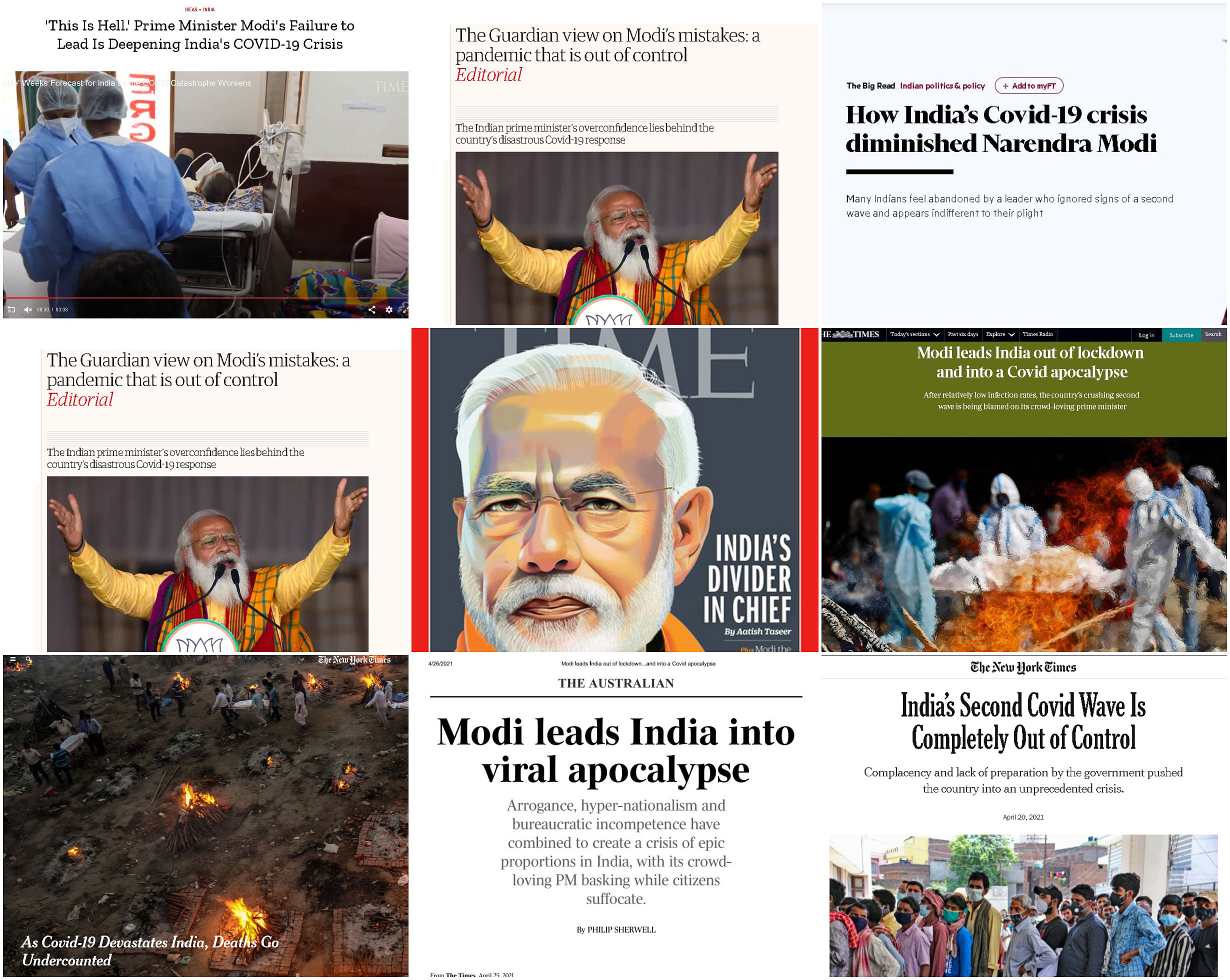Covid-19 crisis: Jolt for ‘Brand Modi’?

'Time’ magazine had Narendra Modi on the cover of its June 2, 2014 edition – hailing him as the “New Face of India”. He had just taken over as the new Prime Minister after leading the Bharatiya Janata Party to a landslide victory in the parliamentary elections held in April-May that year. The magazine published from New York again had in its April 16, 2015 edition an article on Modi, written by none else but the then American President Barack Obama himself, and titled “India’s Reformer-in-Chief”.
The Prime Minister returned to the cover of ‘Time’ on May 7, 2015, when the magazine published an interview with him. He again won an online poll conducted by the magazine among its readers in December 2016 to pick the “Time Person of the Year”.
Cut to May 2019. Modi was again leading the BJP’s campaign to win a second term in the office of the Prime Minister and he was riding high. ‘Time’, however, published a cover article on its May 9, 2019 edition by journalist-novelist Aatish Taseer, calling Modi “India’s Divider-in-Chief”.
And, with the raging second wave of the Covid-19 pandemic wreaking havoc across the country, ‘Time’ put on the cover of its latest edition a picture of the burning pyres in a crematorium in New Delhi – one of the cover articles was headlined “India in Crisis” and the other “How Modi Failed Us”.
As countless people with near and dear ones infected with the SARS-CoV-2 virus waited in long queues before healthcare facilities and ran from pillars to posts to get medicines, hospitals ran out of oxygen and patients died gasping for air, bodies were lined up before burial grounds and crematoriums and inoculation centres shut down due to shortages of vaccines, ‘Time’ is not the only foreign publication that called out the Prime Minister and his government for the mess across India.
The Guardian published from London in an editorial held the overconfidence of the Prime Minister responsible for the crisis. The Times, which also comes out of London, published an article headlined “Modi flounders in India’s gigantic second wave”, lambasting the BJP’s government in New Delhi for “complacency and denial” in its response to the resurgence of the pandemic. “A return of the virus was inevitable. The government’s failures were not,” noted the Economist. “India’s Covid crisis has tarnished Modi’s aura of political invulnerability,” was the headline of one of many articles published by New York Times on the crisis. The Washington Post blamed the “Kumbh Mela” and the election rallies, which Modi, Home Minister Amit Shah and the other leaders of the BJP as well as other political parties had held during electioneering in West Bengal, Kerala, Tamil Nadu, Assam and Puducherry, for the disaster. The Le Monde, published from Paris, held the “unpredictability of the virus” as well as “the lack of anticipation, arrogance and demagoguery” of the Prime Minister responsible.
The Lancet, one of the world’s oldest and most reputed medical journals, minced no words to criticise the Modi Government over its handling of the Covid-19 crisis in India.
The Australian published an article titled “Modi leads India out of lockdown…and into a viral apocalypse”. The Modi Government got the High Commission of India in Canberra to write to the editor of The Australian, dismissing the article as “completely baseless, malicious and slanderous”. New Delhi also got Twitter and Facebook to get some posts and contents about the Covid-19 second wave in India deleted, claiming that those had been spreading misinformation and causing panic among people.
Even the Indian media has, of late, been critical of Modi government’s handling of the pandemic and the social media, whose able management by BJP strategists in favour of Brand Modi had played a key role in BJP’s 2014 landslide victory and its repeat in 2019, is also inundated with anti-establishment posts. Opposition is clearly in no mood to let go the opportunity and is rallying a joint campaign against the government.
BJP also has had a loss of face on the political front. Mamata Banerjee halted the BJP’s march in West Bengal to just 77 in the state polls even as the former had blustered about winning over 200 Assembly seats. BJP had a lead in 128 assembly seats in the 2019 Lok Sabha polls, when it had won 18 Lok Sabha seats. In Tamil Nadu and Kerala, it failed to make a worthwhile impact even though it retained Assam and found solace as a junior party in the victory of NR Congress-led alliance in Puducherry. The defeat in Bengal will rankle as BJP bet high and Modi and Amit Shah led a blitzkrieg campaign.
A clear change in pattern is visible. BJP, which was on a winning trail in state polls of Maharashtra, Haryana, Jharkhand months after its 2014 Lok Sabha election victory, failed to repeat the same feat in these states in 2019 even though it had won Lok Sabha polls the same year with a bigger margin. BJP’s poor show in state polls was visible since the 2017 Gujarat elections in which it got only 99 seats (out of 200) and barely managed to form government. In 2018 came a shock 3:0 defeat in Madhya Pradesh, Rajasthan and Chattisgarh--all ruled by it.
Policy paralysis
Post pandemic, it is now the Modi government’s time to face the “policy paralysis” charge as the deadly disease plays havoc with lives and livelihood in cities and villages alike. With BJP being in power at Centre for seven years and ruling a number of states including UP, Bihar, Madhya Pradesh and Gujarat, questions on the “double engine growth” and the famed “Gujarat model” are being raised.
However, the supporters and leaders of BJP dismiss the “doomsday” predictions for the party. Corona is a once in a century tragedy and Congress, which has ruled the nation for decades, cannot lay all the blame on Modi’s doors for the health sector’s failure to rise to the challenge, they say. In Bengal, they argue BJP’s number in Assembly rose from just three in 2016 to 77 and it has won more than 38% votes in a state where it had neither an organisation nor a local pan state face, thanks to Modi’s charishma.
The fact also remains that most of the political pundits had predicted a decline in BJP’s tally in comparison to 2014 but Modi proved all wrong and BJP won a whopping 300 plus seats in 2019. Similarly, poll predictions had gone horribly wrong in 2017 UP Assembly polls as well, when the BJP won 312 of 384 seats without a CM face, totally banking on Modi’s image.
Rumblings were heard in UP and Delhi with few leaders questioning what the state government and the party organisation were doing in these two places. UP, which has 80 Lok Sabha seats and which goes to polls in early 2022, could be a barometer to measure whether Brand Modi has suffered a dent or not and if yes, how much.
So far, no big leader from the BJP or RSS have come out openly to do fault finding with the leadership as the iron grip of Modi and Shah continues on the organisation. There is a view in the BJP and RSS camp that Modi is still their best bait. It remains to be seen whether Modi manages to reverse the tide again as he had done in 2019. The 2014 Lok Sabha poll was essentially an anti-UPA election after the Manmohan Singh-led government was in power for 10 years. The year 2024 will test whether Modi can, unlike his predecessor, buck the anti-incumbency even after 10 years and more even after the pandemic, which has exposed the chinks in delivery like never before.

